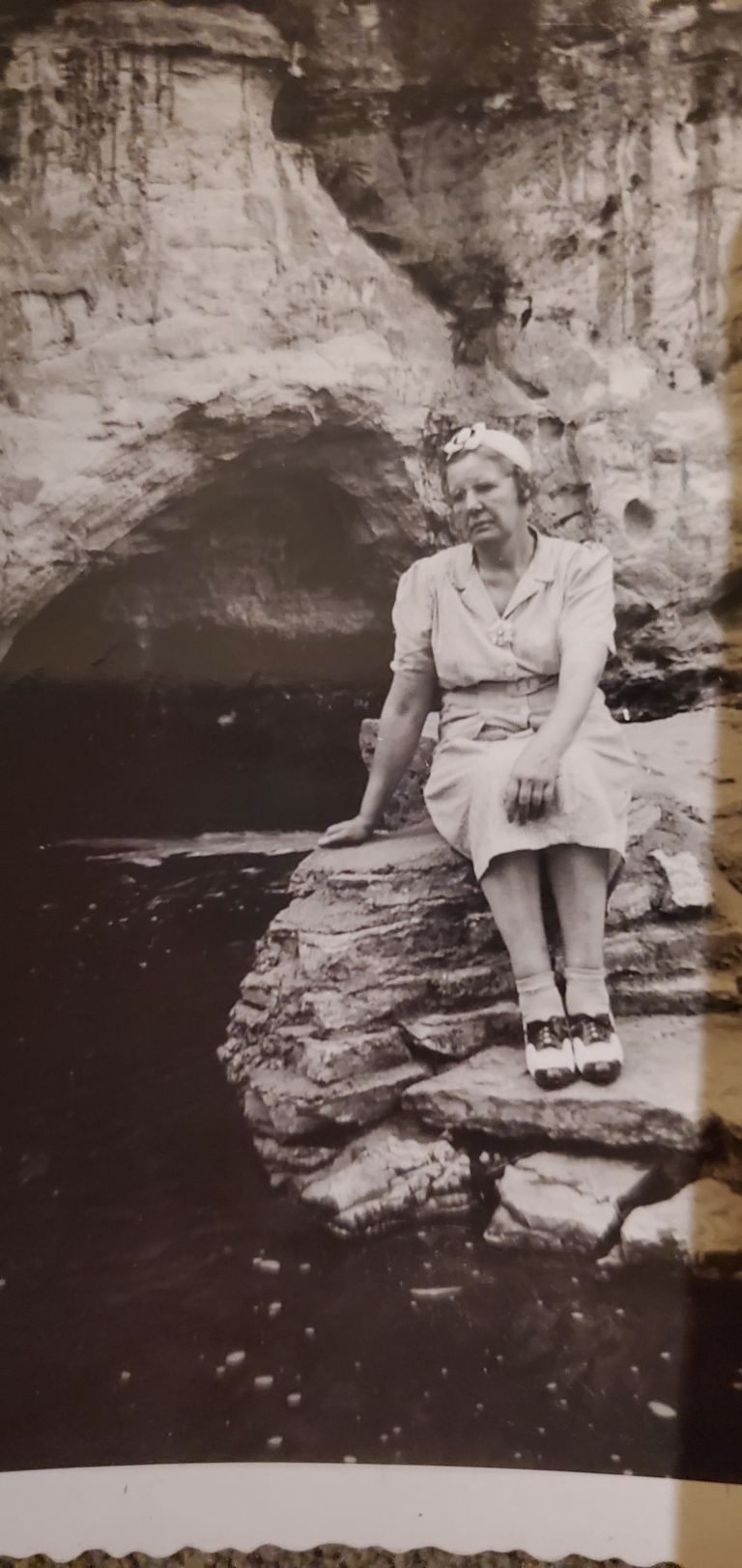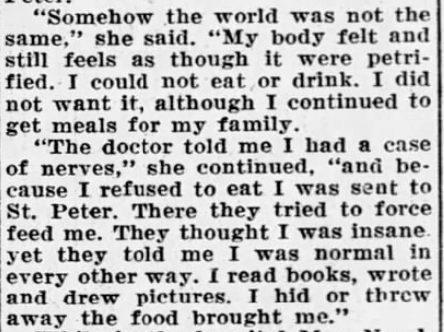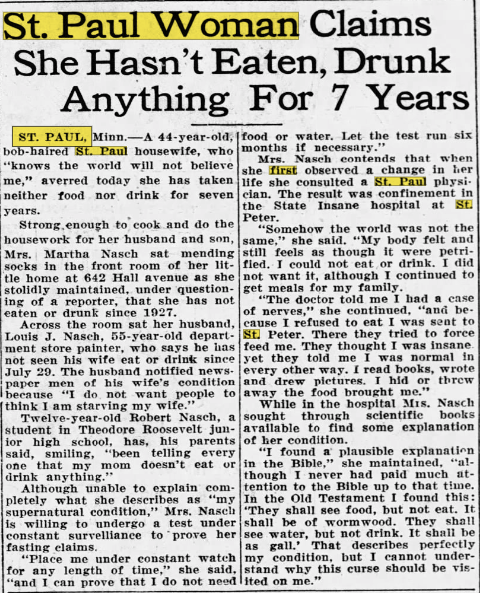
Committed against her will to an asylum. Said she didn’t eat for seven years. My grandmother.
German-American Martha Hattie Gruening Nasch (1894-1970) was a woman literally starving for love. She was also my paternal grandmother.
From 1927 to 1934, Martha told the world that she didn’t eat or drink, spending that time period in the St. Peter State Hospital for the Insane in Minnesota.
The first two photos depict “before” moments in her life. As a young bride of 23, she poses formally, determinedly, and somberly in her wedding day dress. She married my grandfather, Louis J. Nasch (1884-1964), age 29, a union painter, on September 4, 1913, in St. Paul. Both were of German ancestry, 2nd generation, with parents hailing from Eastern Prussia, and Baden and Bavaria, respectively. Germans were one of the largest immigrant groups to settle in Minnesota.
Perhaps Martha could be described as more “handsome” than an elegant beauty. However, her soulful eyes belied an enigmatic sadness which cloaked her demeanor. It’s rare to find a photo of her smiling, often appearing stern, stricken, or perhaps introverted. She was a tall, hardy farm girl, one of 5 siblings from Belle Plaine, Minnesota, with a plain nose and thin lips. She met Louis at a dance after she moved off the farm to the big city of St. Paul. Eight years later, she gave birth to her one and only son, Ralph L. Nasch (1921-2019), pictured in the second photo.
Her Mental Health Declines and a Mysterious Surgery…
Although she doted on her little boy, her mental health soon began to deteriorate. It was alleged that Louis Jr. had an affair. The couple fought bitterly in German, and there were rumors of verbal and physical abuse. Martha had kept a poetry journal during her committal that documented the harrowing details of her residency and her sentimental recollections of the family she missed. She wrote heartbreakingly,
“At home was never happy, we never could agree; I wished that something would occur—to set me once more free.”
Martha underwent a mysterious major medical surgery in 1927 at age 37, and she just wasn’t herself afterwards, even too weak to walk Ralph to school on his first day.
No More Food…
Notably, Martha began to drop weight alarmingly. She told her doctor that she didn’t eat food anymore. Louis Jr. verified her story, and she began to espouse some supernatural beliefs that she no longer needed to eat or drink. At times, she said the devil was out to get her. The doctor diagnosed it as a “case of nerves” and had her committed against her will to the St. Peter State Hospital in January of 1929, where she was to spend the next seven years of her life. No records exist of her committal, other than a notecard with her date of admission, two “escapes,” and her release date noted.
Young Ralph, only six, was able to see his mother on two Sundays a month, after he and his father made the weekly two-hour bus ride down from St. Paul. She was described by Ralph as detached and disinterested, at times. She spent her time writing poetry and corresponding with various strangers who shared her mystical afflictions.

After Seven Years, Released…
In the third photo, Martha is depicted as she was upon release from the mental institution. She appears lifeless and depressed. It is unclear if she was deemed “cured.” She wrote hauntingly of her time there:
“Weak and helpless I was left, I never could get well; the devil came and destroyed my life and changed the world to hell.”
She wrote of the physical abuse she endured by the hospital staff, including forced feedings. When she was released, she weighed only 103 pounds.
Eventually, her physical health was restored. She had the gumption to divorce Louis. Ralph, aged 17, remained with his father. Several years later, she remarried, enjoying a happier relationship. She regained the weight she had lost. She began to smile, reservedly, in photos.
Notoriety Ensues…
For a time, Martha gained some notoriety. She gave newspaper interviews and public talks, even in Vaudeville, proclaiming she didn’t eat for seven years. No explanation was provided for her outrageous claims, and it is pure speculation whether it was a true delusion or a deeply-held belief. The answers remain illusory. Martha’s story was published in over 90 U.S. papers in 1934, and she was often mocked and derided in the sensationalistic press coverage. (“St. Paul Woman Claims She Hasn’t Eaten, Drank Anything for 7 years,” La Cross Tribune and Leader Press, September 20, 1934, clipping of which is seen above and below.)
It’s significant to note that three other German-speaking neighbors in St. Paul also had family members committed to St. Peter during that time period. Martha’s own brother, Leo, died there after a short bout of tuberculosis. Immigrants made up 1/3 of the St. Peter patients. The working poor couldn’t afford good healthcare, and there were few options. The culture at that time also included some anti-German sentiment post-WWI, which caused some schools to quit teaching German, cities and towns to change their German names, and even some Germans to adopt English-sounding last names. Some communities even made it illegal to play German composers, according to Bill Bryson in his book One Summer. Beer drinking could even be seen as treasonous! While it isn’t certain that German-Americans were specifically targeted for insane asylum committal, the immigrants unlikely had the medical, financial, or legal means to resist what was often a mandatory sentence. However, the German-Americans strove to protect their cultural traditions through German-speaking churches and newspapers. Martha, surrounded by her German-American family and neighbors, had a community which sustained her during her darkest times and during her recovery.
We’ll never know all the answers that are hidden behind Martha’s soulful eyes. I was a young child when she died. I choose to believe she was starved for love. Now, 80 years later, her descendants have preserved her legacy by publishing her poems in the book Poems From the Asylum. It is a narrative biography, including her ancestry and genealogy, her poetry, her medical treatment, and her news coverage.


ABOUT THE AUTHOR
Dr. Jodi Decker is the granddaughter of Martha H. Nasch and cowrote the book Poems From the Asylum (2021) with Janelle Molony, Martha’s great-granddaughter. Jodi is a college professor, family historian, and writer. Her interests are in historic insane asylums, insanity, 1920’s and 1930’s U.S. history, and WWII history. Jodi is also a social media content creator for Seven Years Insane, where educational updates, podcasts, and book events are provided on Poems From the Asylum.


